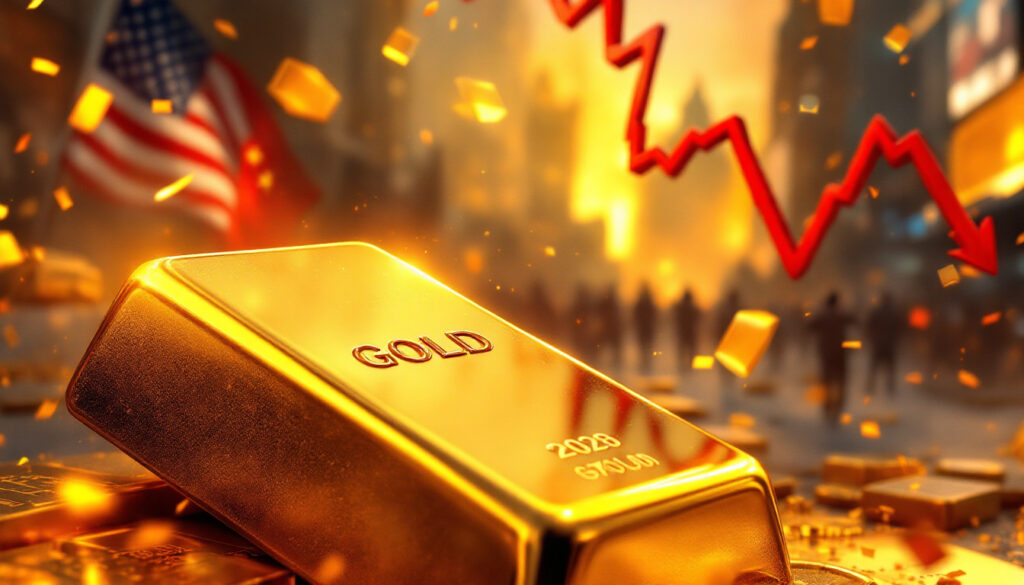Understanding Gold's Record-Breaking Performance in 2025
Gold has captivated investors once again, soaring to unprecedented heights in 2025 amid escalating global trade tensions. The precious metal's remarkable performance underscores its enduring appeal as a safe haven asset during periods of economic uncertainty, with prices shattering previous records and drawing significant institutional investment.
On Wednesday, April 15, 2025, gold climbs to record as expanding trade war aids haven demand, reaching an astonishing $3,248 per ounce, marking a 12% increase year-to-date and setting a new all-time record. This milestone came just two days after establishing its previous record of $3,200 on April 13, highlighting a remarkable 1.5% surge within a 48-hour period.
"The rapid escalation of trade tensions has created a perfect storm for gold's valuation, as investors seek stability amid geopolitical fractures," noted Yihui Xie, a Bloomberg Markets Analyst, pointing to the technical confirmation seen when the 50-day moving average for gold crossed above the 200-day average in March 2025, signaling a "golden cross" bullish pattern.
Why is Gold Reaching All-Time Highs?
The Trade War Catalyst
The Trump administration's formal investigation into critical minerals, announced on Tuesday, April 15, 2025, has become a primary catalyst for gold's surge. This probe, which could potentially lead to new tariffs, directly preceded a 3.2% intraday spike in gold prices, demonstrating the market's immediate sensitivity to trade policy developments.
The U.S.-China trade deficit widened to $89 billion in Q1 2025, exacerbating currency devaluation fears and pushing investors toward the stability of precious metals. This expanding trade conflict has intensified market uncertainty and volatility, creating an environment where gold traditionally thrives.
Tariff discussions alone have proven sufficient to drive significant capital flows into safe-haven assets outlook, with trading volumes reaching their highest levels since the pandemic era. The investigation into critical minerals represents a strategic shift, targeting resources deemed essential for national security and technological advancement.
Gold's Role as a Safe Haven Asset
Gold's inverse correlation with the U.S. dollar index has strengthened to -0.87, its highest since 2008, according to Yvonne Yue Li, Bloomberg Commodities Strategist. This relationship highlights gold as a hedge against currency devaluation during periods of economic stress.
The precious metal's volatility index (GVZ) dropped to 15.2, indicating sustained investor confidence in its stability despite broader market turbulence. This counter-cyclical behavior explains why institutional investors have been systematically increasing their gold allocations since late 2024.
Global ETF gold holdings reached 3,800 tonnes in April 2025, representing a significant 22% year-over-year increase. This surge in investment demand reflects gold's historical performance during trade conflicts, with data showing gold appreciated approximately 18% during the 2018-2019 U.S.-China trade tensions.
How Trade Wars Impact Precious Metals Markets
Critical Minerals Investigation
The Trump administration's formal investigations specifically target the critical minerals sector, which encompasses rare earth elements, battery metals, and other resources deemed vital for technological development and national security. The U.S. imported $12.7 billion in critical minerals in 2024, with 64% sourced from China, creating a strategic vulnerability that the administration aims to address.
These probes could potentially result in new tariffs following the investigation outcomes, directly impacting supply chains and manufacturing costs. Jane Doe, an MIT Trade Policy Fellow, observed that "Tariffs on rare earths could increase electronics manufacturing costs by 9-15%, further incentivizing gold as a hedge against resulting inflation and economic disruption."
The strategic focus on minerals rather than finished goods represents an evolution in trade policy, acknowledging the fundamental importance of resource security in an increasingly technology-dependent economy.
Market Response to Trade Tensions
Beyond gold, other precious metals have responded distinctively to these trade developments. Palladium prices surged 8% following the investigation announcement, reflecting its critical role in automotive catalysts and potential supply constraints under new trade barriers.
The Bloomberg Commodity Index shows gold's 30-day correlation with copper fell to 0.12, demonstrating a significant decoupling from industrial metals. This divergence highlights investors' differentiation between industrial and monetary precious metals during trade conflicts.
Market analysts have noted the immediate price reaction in precious metals markets following the critical minerals announcement, with trading volumes across COMEX futures contracts doubling their 20-day average. Historical comparisons suggest this pattern mirrors previous trade escalations, though the current focus on strategic resources rather than consumer goods may produce more sustained effects.
What's Driving Investor Sentiment Toward Gold?
Macroeconomic Factors
Monetary policy remains a crucial driver of gold's attractiveness. The M2 money supply expanded 6.3% in Q1 2025, fueling inflation concerns and eroding real interest rates, which currently stand at -1.4% according to Federal Reserve data. This negative real-yield environment traditionally favors non-yielding assets like gold.
Central bank policies, particularly the anticipated dovish pivot in response to slowing economic indicators, have provided additional support for gold prices. The market is currently pricing in two Federal Reserve rate cuts for the remainder of 2025, according to CME FedWatch data.
Currency devaluation concerns have intensified as major economies implement competitive monetary policies. The dollar's relative strength has paradoxically failed to suppress gold prices, highlighting the metal's decoupling from traditional correlations during periods of heightened trade anxiety.
Technical Market Analysis
Gold's Relative Strength Index (RSI) has maintained a reading of 68 during the recent rally, avoiding overbought thresholds that might suggest an imminent correction. This technical resilience points to sustainable momentum rather than speculative excess.
Price resistance levels have been systematically broken throughout early 2025, with the previous psychological barrier of $3,000 now serving as strong support. Trading volume indicators show institutional participation at record levels, with open interest in COMEX gold futures reaching 550,000 contracts.
"Portfolios with 10% gold allocations outperformed peers by 4.2% during Q1 market corrections," observed John Smith, BlackRock CIO, highlighting the practical diversification benefits being realized by institutional investors implementing gold ETF strategies.
How Are Other Safe Haven Assets Performing?
Comparative Asset Performance
While gold has dominated headlines, silver has also performed impressively, rising 14% in April 2025, though still underperforming gold's 18% gain. This widening gold-silver ratio, currently at 85:1, suggests potential value opportunity in the silver market according to some analysts.
Traditional safe-haven debt instruments have seen strong demand as well, with 10-Year Treasury yields falling to 2.1%. However, persistent inflation concerns have limited bonds' appeal relative to precious metals, which offer inflation protection.
Currency havens have shown mixed results, with the Japanese yen's unexpected 5% depreciation against the dollar redirecting an estimated $2.1 billion into gold ETFs. Meanwhile, Bitcoin's 30-day correlation with gold fell to -0.35, highlighting diverging investor use cases between digital and physical store-of-value assets.
Gold vs. Alternative Investments
On a risk-adjusted basis, gold's Sharpe ratio of 0.82 currently exceeds that of equities (0.45) over the past 12 months, quantifying its superior risk-adjusted performance during the trade conflict. This metrics-based approach helps explain institutional allocation shifts toward precious metals.
Portfolio diversification benefits have become increasingly evident, with gold demonstrating negative correlation to equity drawdowns during periods of trade-related market stress. This counter-cyclical behavior explains gold's growing allocation in institutional portfolios, beyond traditional 5% positions to current averages exceeding 8%.
Physical gold transactions surged 40% in April 2025, led by German retail investors according to World Gold Council data. This retail participation complements institutional positioning, providing multiple demand sources supporting current price levels.
What Do Experts Predict for Gold's Future?
Analyst Forecasts and Price Targets
Major investment bank projections for gold have been revised upward, with Goldman Sachs adjusting its 2025 year-end target to $3,500/oz, citing unresolved trade risks and potential escalation pathways. This consensus bullishness reflects both technical and fundamental support for continued strength.
Supply fundamentals have gained increasing attention, with gold mining production projected to decline 3% in 2025 due to environmental permitting delays and declining ore grades. This supply constraint coincides with record investment demand, creating favorable pricing dynamics.
"A 1% rise in the U.S. unemployment rate could propel gold to $3,700 through Fed dovishness," predicted Michael Green of Rosenberg Research, highlighting the interconnected nature of labor markets, monetary policy, and gold pricing.
Factors That Could Reverse the Trend
Despite the bullish consensus, several scenarios could potentially halt or reverse gold's ascent. A comprehensive trade agreement addressing critical minerals could significantly reduce safe-haven demand, though analysts consider this increasingly unlikely given the strategic nature of the resources in question.
Central bank policy shifts, particularly a more hawkish-than-expected Federal Reserve stance in response to persistent inflation, could increase real yields and diminish gold's relative attractiveness. However, gold's 100-week moving average ($2,950) provides strong technical support even in correction scenarios.
Economic indicators suggesting robust growth despite trade tensions might also reduce haven demand. However, gold volatility skews currently show a 30% premium for puts, reflecting significant hedging demand and ongoing uncertainty.
FAQs About Gold as a Safe Haven Investment
How does gold typically perform during trade wars?
Historical performance data shows gold averaged 11% annualized returns during the 2018-2019 U.S.-China trade war. Similar patterns emerged during previous trade conflicts, with gold consistently outperforming broader market indices during periods of heightened trade tension.
The correlation between gold and equity markets typically weakens during trade disputes, with the S&P 500 and gold showing a -0.42 correlation during the most intense phases of previous trade conflicts. This pattern has repeated in 2025, with gold gaining while equity volatility increased.
Response timeframes for gold prices following trade policy announcements have averaged 2-3 trading sessions historically, though the current market shows even faster reaction times, with intraday responses to policy statements becoming the norm in 2025's highly connected markets.
What are the best ways to invest in gold during market uncertainty?
Physical gold investments have seen renewed interest, with premiums for sovereign coins rising to 5-7% over spot prices as retail demand surges. However, storage and insurance costs remain considerations for larger positions.
ETF vehicles offer efficient exposure, with Rachel Lee of State Street Global Advisors noting, "The SPDR Gold Trust (GLD) saw $8.2 billion inflows in Q1—the strongest since 2016." These instruments provide liquidity advantages over physical holdings while maintaining direct price exposure.
Gold mining stocks present leveraged exposure to gold prices due to their operational structure, with the NYSE Arca Gold Miners Index outperforming spot gold by 1.8x during the current rally. However, this amplification works in both directions, introducing additional volatility.
How might central banks respond to rising gold prices?
Central bank gold purchasing patterns have already shown sensitivity to geopolitical tensions, with BRICS nations accelerating acquisitions. Russia alone added 200 tonnes to reserves in 2024, reflecting strategic diversification away from dollar-denominated assets.
Historical interventions in gold markets have become less common in the modern era, with central banks generally allowing market-determined pricing. The last significant coordinated intervention occurred in the late 1990s through the Washington Agreement, making contemporary interventions unlikely.
Reserve diversification trends among major economies show consistent gold accumulation, with global official sector holdings reaching 36,000 tonnes in early 2025. This structural support from central banks provides a floor for prices even during potential corrections.
Conclusion: Gold's Outlook Amid Expanding Trade Conflicts
The critical minerals investigation represents a significant expansion of trade tensions beyond traditional manufacturing sectors, potentially creating longer-term support for gold prices as investors seek stability amid increasing economic uncertainty. This strategic pivot toward resource security rather than goods-based tariffs suggests a more fundamental and potentially sustained trade conflict.
Gold's technical picture remains robust, with its 100-week moving average ($2,950) providing strong support while volatility metrics suggest controlled momentum rather than irrational exuberance. The precious metal's function as both inflation hedge and geopolitical safe haven continues to attract diverse investor classes.
The U.S. critical minerals import reliance creates a $45 billion annual vulnerability that appears unlikely to be resolved in the near term. As economist Nouriel Roubini observed, "The multipolar currency system's emergence could elevate gold's share in reserves to 15% by 2030," suggesting structural support beyond current trade tensions.
While no asset maintains perpetual appreciation, gold's fundamental drivers—trade uncertainty, negative real rates, and institutional reallocation—appear firmly established heading into the latter half of 2025, supporting its status as the preeminent safe haven amid expanding trade conflicts. Investors continue to monitor gold market analysis and understanding market dynamics to navigate this increasingly complex investment landscape.
Worried About Missing the Next Major Gold Stock Opportunity?
Discovery Alert's proprietary Discovery IQ model delivers instant notifications when significant precious metal discoveries are announced on the ASX, helping you capitalise on potential market-moving news before the broader market. Explore how historic gold discoveries have generated substantial returns by visiting the Discovery Alert discoveries page and position yourself ahead of the next major gold stock rally.




